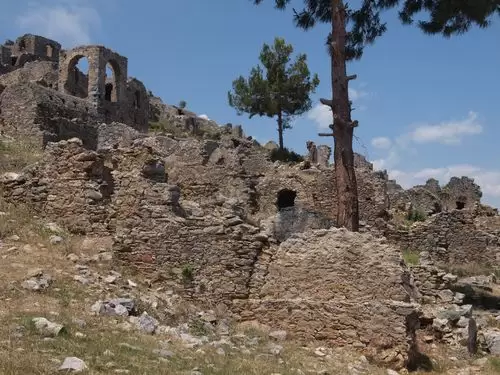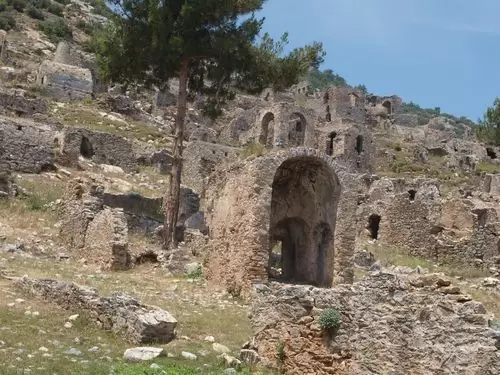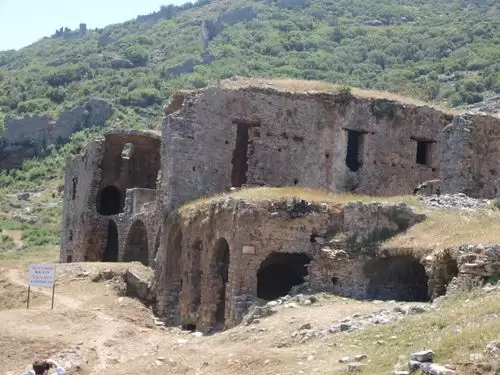On the wind-swept shores of Turkey, where the Mediterranean waves gently kiss the land, lies the mysterious Necropolis of Anemurium. Dating back to ancient times, this archaeological site offers a silent journey through the ages, where each tomb tells a story, each stone whispers the memory of a bygone era.
Exploring Anemurium is to walk in the footsteps of the ancients, where Roman and Byzantine remains intertwine in a historical dance. Without delving into technical details, it suffices to say that this necropolis, with its mausoleums and cenotaphs, provides a window into the burial rites and lives of the civilizations that once thrived here. Away from the crowds, this place invites reflection and contemplation, offering an exceptional view of the sea, as if to remind us of the vastness of time and the brevity of life.

Anemurium • Anemurium Necropolis

Anemurium • Anemurium Necropolis

Anemurium • Anemurium Necropolis
The Necropolis of Anemurium, nestled in what is now modern Turkey, is a site steeped in history and mystery, reflecting the complexities of the Roman and Byzantine eras it spanned. While specific construction statistics such as duration, cost, and labor involved are scarce due to the ancient nature of this site and the lack of contemporary records, the architectural features and historical context offer insights into its creation and significance.
Hidden Stories and Construction Motivations
The establishment of the Necropolis at Anemurium was deeply influenced by the Roman and Byzantine traditions of commemorating the dead. These civilizations placed a high value on the afterlife, leading to the creation of elaborate burial sites. The choice to build such a vast necropolis here was likely influenced by Anemurium's significance as a bustling port city, signifying a blend of practical location choice and the cultural practices of honoring the deceased with monumental structures.
Historical Significance
Anemurium's strategic position made it a crucial point for trade and military activities, which also exposed it to various invasions and conflicts, particularly during the later Roman and early Byzantine periods. These events did not just shape its historical trajectory but also influenced the necropolis itself, which served as the final resting place for many of the city's inhabitants across different epochs.
Transformations and Cultural Impact
Over the centuries, the Necropolis of Anemurium has undergone significant transformations. Initially rooted in Roman architectural and burial traditions, it gradually incorporated Byzantine influences, especially in the form of Christian iconography found on tombstones and within burial chambers. This evolution reflects broader shifts in the religious and cultural landscape of the region, illustrating how Anemurium mirrored the transition from the pagan Roman world to a predominantly Christian Byzantine society.
Current State of Conservation and Challenges
Today, the Necropolis of Anemurium faces numerous conservation challenges. Natural erosion, unauthorized excavations, and the lack of comprehensive conservation strategies have all threatened the integrity of the site. Efforts to preserve this ancient necropolis are hampered by limited funding and resources, as well as the need for expert involvement in restoration and preservation projects.
The current state of conservation requires a balanced approach that respects the site's historical significance while addressing the practical challenges of preservation. This involves not only protecting the physical structures but also ensuring that the site remains accessible and informative for future generations interested in exploring the depths of ancient history.
While detailed statistics on the construction and specific historical events related to the Necropolis of Anemurium might be limited, the site's architectural features and its evolution over time provide valuable insights into the cultural significance of this ancient necropolis. The challenges it faces today underscore the importance of ongoing research, conservation efforts, and international cooperation in preserving such irreplaceable glimpses into our collective past.
For in-depth research and the latest findings on Anemurium, scholars and interested individuals are encouraged to consult archaeological reports, historical research publications, and studies conducted by institutions specializing in ancient history and archaeology. These sources offer the most accurate and comprehensive information available on sites like the Necropolis of Anemurium.
The Necropolis of Anemurium in Turkey is a captivating testament to the architectural innovation and technical mastery of the Roman and Byzantine periods. While specific construction statistics such as the exact duration, cost, and labor involved are challenging to ascertain due to the historical nature of the site and the scarcity of contemporary records, the architectural features present offer substantial insights into the expertise of the builders and the cultural significance of the necropolis.
Architectural Innovation and Technical Mastery
- Diversity of Tomb Types: The Necropolis of Anemurium showcases a wide range of tomb types, from simple in-ground burials to elaborate sarcophagi and family mausoleums. This diversity indicates a high level of innovation in funerary architecture, catering to different social statuses and personal preferences within the community.
- Construction Techniques: The use of local limestone and careful craftsmanship in the creation of the tombs demonstrates the builders' technical skills and their ability to maximize local resources. The intricacy of the sarcophagi, some adorned with detailed carvings and inscriptions, further illustrates the artisans' mastery over their materials.
- Integration with the Landscape: The necropolis is strategically situated to overlook the Mediterranean Sea, showing an appreciation for natural beauty and a thoughtful consideration in the placement of tombs. This harmonious integration of architecture with the surrounding landscape reflects a sophisticated understanding of environmental aesthetics and spiritual symbolism.
Contributions to Global Recognition
- Cultural Synthesis: The architecture of the Necropolis of Anemurium embodies a blend of Roman and Byzantine cultural influences, reflecting the transition and coexistence of these two significant periods. The site serves as a physical record of the region's complex cultural history, offering insights into the evolving practices of commemoration and the synthesis of architectural styles.
- Artistic Merit: The artistic details found in tomb decorations, including relief sculptures and inscriptions, contribute to the necropolis's international significance. These elements not only display the artistic achievements of the time but also provide valuable information about the cultural, religious, and social aspects of the inhabitants' lives.
- Preservation of History: The ongoing archaeological research and conservation efforts at the Necropolis of Anemurium highlight its importance as a historical and cultural heritage site. The knowledge gained from studying the necropolis helps to preserve the memory of ancient civilizations and fosters a greater appreciation for humanity's architectural and artistic legacy.
Current State of Conservation and Challenges
The Necropolis of Anemurium faces significant conservation challenges, including weathering, erosion, and the potential threat from looting and unregulated tourism. Efforts to preserve the site are critical for maintaining its structural integrity and protecting its historical value. Conservation initiatives require collaboration between archaeologists, historians, and the global community to ensure that the necropolis remains a source of knowledge and inspiration for future generations.
While specific construction data may be limited, the architectural achievements and the enduring legacy of the Necropolis of Anemurium underscore its significance in the annals of world heritage. Its unique characteristics not only reflect the technological and artistic innovation of its creators but also contribute to our understanding of the cultural richness of the ancient world.
For detailed information and research on Anemurium, academic publications, archaeological excavation reports, and historical analyses offer the most reliable insights. These sources provide a comprehensive view of the site's architectural significance and its place within the broader context of Roman and Byzantine history.


 English (UK)
English (UK)  Français (France)
Français (France)  Nederlands (nl-NL)
Nederlands (nl-NL)